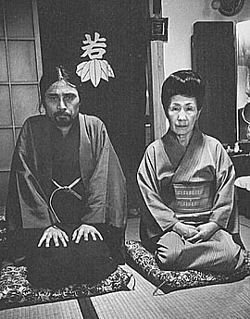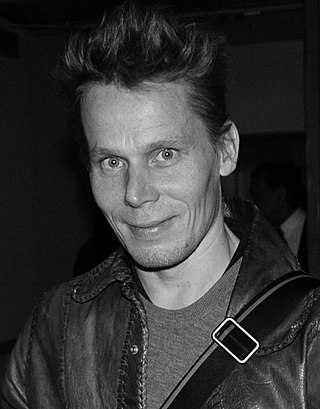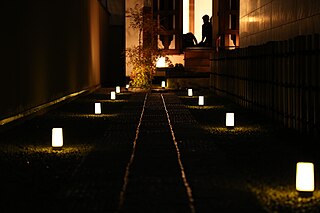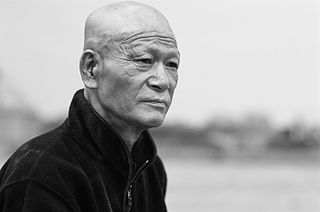
Butoh is a form of Japanese dance theatre that encompasses a diverse range of activities, techniques and motivations for dance, performance, or movement. Following World War II, butoh arose in 1959 through collaborations between its two key founders, Tatsumi Hijikata and Kazuo Ohno. The art form is known to "resist fixity" and is difficult to define; notably, founder Hijikata Tatsumi viewed the formalisation of butoh with "distress". Common features of the art form include playful and grotesque imagery, taboo topics, and extreme or absurd environments. It is traditionally performed in white body makeup with slow hyper-controlled motion. However, with time butoh groups are increasingly being formed around the world, with their various aesthetic ideals and intentions.

Tatsumi Hijikata was a Japanese choreographer, and the founder of a genre of dance performance art called Butoh. By the late 1960s, he had begun to develop this dance form, which is highly choreographed with stylized gestures drawn from his childhood memories of his northern Japan home. It is this style which is most often associated with Butoh by Westerners.

Kazuo Ohno was a Japanese dancer who became a guru and inspirational figure in the dance form known as Butoh. He is the author of several books on Butoh, including The Palace Soars through the Sky, Dessin, Words of Workshop, and Food for the Soul. The latter two were published in English as Kazuo Ohno's World: From Without & Within (2004).
María de Buenos Aires is a tango opera with music by Ástor Piazzolla and libretto by Horacio Ferrer that premiered at the Sala Planeta in Buenos Aires on 8 May 1968.

Julio Adrián Lojo Bocca is an Argentine ballet dancer. Bocca spent twenty years as a principal dancer with American Ballet Theatre. From 2010 to 2018, he served as artistic director of the National Ballet of Uruguay, administered by SODRE, the country's broadcasting and cultural authority.

Junichi Kakizaki is a Japanese artist, sculptor, floral artist, nature art artist, land art artist and environmental artist. He exhibits regularly both in Japan and internationally. Since 1992, he has mainly worked on scenography. He brought a floral design representation in area of contemporary art. His daughter, Memi, is a former member of Japanese idol group Hinatazaka46.
Gustavo Aguerre is an artist, photographer, curator, writer, and theatre designer.

Atsushi Takenouchi is a Japanese Butoh dancer who performs various solo works as well as collaborations; such as "Enclosure" performed in conjunction with Brighton based arts company, Red Earth, on Hambledon Hill, Dorset.
Tadashi Endo is a butoh dancer resident in Göttingen, Germany. Endo is a Japanese national. He studied theatre direction in Vienna before touring Europe giving solo performances accompanied by leading jazz performers. In 1980, he was hired as head of a theater program for the city of Northeim, where he worked until 1986. In 1992, he founded the MAMU butoh center in the nearby university city of Göttingen. The center holds performances as well as training students of the dance form and holding an annual festival in the Goettingen Junges Theater. Endo also tours internationally. In 2009, he choreographed Georg Friedrich Händel's opera Admeto, directed by Doris Dörrie and performed at the Edinburgh International Festival.

Luis Pereyra is a dancer and choreographer of Tango Argentino and Argentine folk dances.
Fernando Egozcue is an Argentinian guitarist and composer.

Tero Kalevi Saarinen is a Finnish dance artist and choreographer, and Artistic Director of Tero Saarinen Company. Saarinen has made an international career as both a dancer and choreographer.
Colon Theater Ballet is a ballet company based in Buenos Aires, Argentina. The company is attached to the Colon Theater, which is also home to the Buenos Aires Philharmonic orchestra and the Colon Theater Opera company. It was established in 1925 and is the oldest ballet company in South America.
El Sonido de mi Tierra is a company from Argentina, for Tango Argentino and Folklore Argentino, founded by Luis Pereyra in 1996. "El Sonido de mi Tierra" means "The sound of my land". The Great Dance of Argentina is the international name of the same company, but used outside of Argentina and Spanish speaking countries. Both names are of the same company and same production.
Akira Kasai (1943) is a Japanese butoh dancer and choreographer, who despite being significantly younger than mentors Kazuo Ohno and Tatsumi Hijikata, is considered to be pioneers of the art form along with them. Kasai trained in other forms of dance, but turned to butoh in the 1960s when he met and began to work with these two men. He started his own studio in 1971 but closed it in 1979 to move and study Eurythmy in Germany. He did not dance professionally at the time and for years after his return to Japan in 1986 he stayed off the stage stating that he felt too disconnected from Japanese society to perform. He returned to professional dance in 1994, with the work Saraphita and revived his studio Tenshi kan, now influenced by Eurythmy and other dance principles. He has since performed, choreographed and taught in Asia, the Americas and Europe, but his choreography is sufficiently different from most other butoh that its authenticity has been questioned.

The Kyoto Butoh-kan is a small theatre space in Kyoto, Japan that is devoted to Butoh-dance.

Kō Murobushi was a Japanese dancer and choreographer who was a leading inheritor of Tatsumi Hijikata's original vision of Butoh.

Ana Itelman was a Chilean-born dancer and choreographer, who spent most of her career in Argentina and the United States. Serving as a professor at Bard College and then director of the school of dance, she toured internationally between 1957 and 1969. In 1970, she returned to Argentina and established a contemporary dance theater. She was honored with the Konex Award for choreography in 1989.
Isa Soares is a Brazilian-born Argentine dancer and activist involved in creating awareness of the African traditions of Argentina and fighting racism against Afro-Argentine peoples. She was one of the pioneers in developing African dance interpretation and instruction in Argentina.
Nakajima Natsu was a Japanese dancer and one of the first female butoh dancers. She studied with Ohno Kazuo and worked with Hijikata Tatsumi. She also founded the dance company Muteki-sha in 1969.









